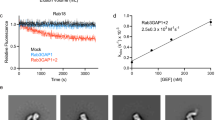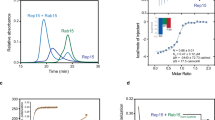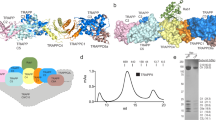Abstract
The small GTPase Rab11 and its effectors FIP3 and Rabin8 are essential to membrane-trafficking pathways required for cytokinesis and ciliogenesis. Although effector binding is generally assumed to be sequential and mutually exclusive, we show that Rab11 can simultaneously bind FIP3 and Rabin8. We determined crystal structures of human Rab11–GMPPNP–Rabin8 and Rab11–GMPPNP–FIP3–Rabin8. The structures reveal that the C-terminal domain of Rabin8 adopts a previously undescribed fold that interacts with Rab11 at an unusual effector-binding site neighboring the canonical FIP3-binding site. We show that Rab11–GMPPNP–FIP3–Rabin8 is more stable than Rab11–GMPPNP–Rabin8, owing to direct interaction between Rabin8 and FIP3 within the dual effector–bound complex. The data allow us to propose a model for how membrane-targeting complexes assemble at the trans-Golgi network and recycling endosomes, through multiple weak interactions that create high-avidity complexes.
This is a preview of subscription content, access via your institution
Access options
Subscribe to this journal
Receive 12 print issues and online access
$259.00 per year
only $21.58 per issue
Buy this article
- Purchase on SpringerLink
- Instant access to full article PDF
Prices may be subject to local taxes which are calculated during checkout





Similar content being viewed by others
References
D'Souza-Schorey, C. & Chavrier, P. ARF proteins: roles in membrane traffic and beyond. Nat. Rev. Mol. Cell Biol. 7, 347–358 (2006).
Stenmark, H. Rab GTPases as coordinators of vesicle traffic. Nat. Rev. Mol. Cell Biol. 10, 513–525 (2009).
Nachury, M.V., Seeley, E.S. & Jin, H. Trafficking to the ciliary membrane: how to get across the periciliary diffusion barrier? Annu. Rev. Cell Dev. Biol. 26, 59–87 (2010).
Ao, X., Zou, L. & Wu, Y. Regulation of autophagy by the Rab GTPase network. Cell Death Differ. 21, 348–358 (2014).
Faini, M., Beck, R., Wieland, F.T. & Briggs, J. Vesicle coats: structure, function, and general principles of assembly. Trends Cell Biol. 23, 279–288 (2013).
Pfeffer, S.R. Rab GTPases: specifying and deciphering organelle identity and function. Trends Cell Biol. 11, 487–491 (2001).
Ullrich, O. Rab11 regulates recycling through the pericentriolar recycling endosome. J. Cell Biol. 135, 913–924 (1996).
Chen, W., Feng, Y., Chen, D. & Wandinger-Ness, A. Rab11 Is required for trans-Golgi network–to–plasma membrane transport and a preferential target for GDP dissociation inhibitor. Mol. Biol. Cell 9, 3241–3257 (1998).
Ren, M. et al. Hydrolysis of GTP on rab11 is required for the direct delivery of transferrin from the pericentriolar recycling compartment to the cell surface but not from sorting endosomes. Proc. Natl. Acad. Sci. USA 95, 6187–6192 (1998).
Skop, A.R., Bergmann, D., Mohler, W.A. & White, J.G. Completion of cytokinesis in C. elegans requires a brefeldin A-sensitive membrane accumulation at the cleavage furrow apex. Curr. Biol. 11, 735–746 (2001).
Deretic, D. Crosstalk of Arf and Rab GTPases en route to cilia. Small GTPases 4, 70–77 (2013).
Pellinen, T. Integrin traffic. J. Cell Sci. 119, 3723–3731 (2006).
Nachury, M.V. et al. A core complex of BBS proteins cooperates with the GTPase Rab8 to promote ciliary membrane biogenesis. Cell 129, 1201–1213 (2007).
Westlake, C.J. et al. Primary cilia membrane assembly is initiated by Rab11 and transport protein particle II (TRAPPII) complex-dependent trafficking of Rabin8 to the centrosome. Proc. Natl. Acad. Sci. USA 108, 2759–2764 (2011).
Mazelova, J. et al. Ciliary targeting motif VxPx directs assembly of a trafficking module through Arf4. EMBO J. 28, 183–192 (2009).
Sung, C.-H. & Leroux, M.R. The roles of evolutionarily conserved functional modules in cilia-related trafficking. Nat. Cell Biol. 15, 1387–1397 (2013).
Wang, J., Morita, Y., Mazelova, J. & Deretic, D. The Arf GAP ASAP1 provides a platform to regulate Arf4- and Rab11–Rab8-mediated ciliary receptor targeting. EMBO J. 31, 4057–4071 (2012).
Singla, V. The primary cilium as the cell's antenna: signaling at a sensory organelle. Science 313, 629–633 (2006).
Pazour, G.J. et al. Chlamydomonas IFT88 and its mouse homologue, polycystic kidney disease gene tg737, are required for assembly of cilia and flagella. J. Cell Biol. 151, 709–718 (2000).
Badano, J.L., Mitsuma, N., Beales, P.L. & Katsanis, N. The ciliopathies: an emerging class of human genetic disorders. Annu. Rev. Genomics Hum. Genet. 7, 125–148 (2006).
Fliegauf, M., Benzing, T. & Omran, H. When cilia go bad: cilia defects and ciliopathies. Nat. Rev. Mol. Cell Biol. 8, 880–893 (2007).
Sharma, N., Berbari, N.F. & Yoder, B.K. Ciliary dysfunction in developmental abnormalities and diseases. Curr. Top. Dev. Biol. 85, 371–427 (2008).
Deretic, D. & Papermaster, D.S. Polarized sorting of rhodopsin on post-Golgi membranes in frog retinal photoreceptor cells. J. Cell Biol. 113, 1281–1293 (1991).
Follit, J.A. et al. Arf4 is required for mammalian development but dispensable for ciliary assembly. PLoS Genet. 10, e1004170 (2014).
Deretic, D. et al. Rhodopsin C terminus, the site of mutations causing retinal disease, regulates trafficking by binding to ADP-ribosylation factor 4 (ARF4). Proc. Natl. Acad. Sci. USA 102, 3301–3306 (2005).
Deretic, D., Schmerl, S., Hargrave, P.A., Arendt, A. & McDowell, J.H. Regulation of sorting and post-Golgi trafficking of rhodopsin by its C-terminal sequence QVS(A)PA. Proc. Natl. Acad. Sci. USA 95, 10620–10625 (1998).
Shin, O.H., Ross, A.H., Mihai, I. & Exton, J.H. Identification of arfophilin, a target protein for GTP-bound class II ADP-ribosylation factors. J. Biol. Chem. 274, 36609–36615 (1999).
Schonteich, E. et al. Molecular characterization of Rab11–FIP3 binding to ARF GTPases. Eur. J. Cell Biol. 86, 417–431 (2007).
Hickson, G.R.X. et al. Arfophilins are dual Arf/Rab 11 binding proteins that regulate recycling endosome distribution and are related to Drosophila nuclear fallout. Mol. Biol. Cell 14, 2908–2920 (2003).
Horgan, C.P. et al. Rab11–FIP3 is critical for the structural integrity of the endosomal recycling compartment. Traffic 8, 414–430 (2007).
Wang, J. & Deretic, D. The Arf/Rab11 effector FIP3 acts synergistically with the Arf GAP ASAP1 to direct Rabin8 in ciliary receptor targeting. J. Cell Sci. 128, 1375–1385 (2015).
Inoue, H., Ha, V.L., Prekeris, R. & Randazzo, P.A. Arf GTPase-activating protein ASAP1 interacts with Rab11 effector FIP3 and regulates pericentrosomal localization of transferrin receptor-positive recycling endosome. Mol. Biol. Cell 19, 4224–4237 (2008).
Knödler, A. et al. Coordination of Rab8 and Rab11 in primary ciliogenesis. Proc. Natl. Acad. Sci. USA 107, 6346–6351 (2010).
Moritz, O.L. et al. Mutant rab8 impairs docking and fusion of rhodopsin-bearing post-Golgi membranes and causes cell death of transgenic Xenopus rods. Mol. Biol. Cell 12, 2341–2351 (2001).
Wang, J. & Deretic, D. Molecular complexes that direct rhodopsin transport to primary cilia. Prog. Retin. Eye Res. (2014).
Guo, Z., Hou, X., Goody, R.S. & Itzen, A. Intermediates in the guanine nucleotide exchange reaction of Rab8 protein catalyzed by guanine nucleotide exchange factors Rabin8 and GRAB. J. Biol. Chem. 288, 32466–32474 (2013).
Feng, S. et al. A Rab8 guanine nucleotide exchange factor-effector interaction network regulates primary ciliogenesis. J. Biol. Chem. 287, 15602–15609 (2012).
Vetter, I.R. & Wittinghofer, A. The guanine nucleotide-binding switch in three dimensions. Science 294, 1299–1304 (2001).
Burke, J.E. et al. Structures of PI4KIIIβ complexes show simultaneous recruitment of Rab11 and its effectors. Science 344, 1035–1038 (2014).
Eathiraj, S., Mishra, A., Prekeris, R. & Lambright, D.G. Structural basis for Rab11-mediated recruitment of FIP3 to recycling endosomes. J. Mol. Biol. 364, 121–135 (2006).
Shiba, T. et al. Structural basis for Rab11-dependent membrane recruitment of a family of Rab11-interacting protein 3 (FIP3)/Arfophilin-1. Proc. Natl. Acad. Sci. USA 103, 15416–15421 (2006).
Hattula, K., Furuhjelm, J., Arffman, A. & Peränen, J.A. Rab8-specific GDP/GTP exchange factor is involved in actin remodeling and polarized membrane transport. Mol. Biol. Cell 13, 3268–3280 (2002).
Krissinel, E. & Henrick, K. Inference of macromolecular assemblies from crystalline state. J. Mol. Biol. 372, 774–797 (2007).
Burguete, A.S., Fenn, T.D., Brunger, A.T. & Pfeffer, S.R. Rab and Arl GTPase family members cooperate in the localization of the golgin GCC185. Cell 132, 286–298 (2008).
Horgan, C.P., Hanscom, S.R., Jolly, R.S., Futter, C.E. & McCaffrey, M.W. Rab11–FIP3 links the Rab11 GTPase and cytoplasmic dynein to mediate transport to the endosomal-recycling compartment. J. Cell Sci. 123, 181–191 (2010).
McKenney, R.J., Huynh, W., Tanenbaum, M.E., Bhabha, G. & Vale, R.D. Activation of cytoplasmic dynein motility by dynactin-cargo adapter complexes. Science 345, 337–341 (2014).
Nie, Z. et al. A BAR domain in the N terminus of the Arf GAP ASAP1 affects membrane structure and trafficking of epidermal growth factor receptor. Curr. Biol. 16, 130–139 (2006).
Isabet, T., Montagnac, G. & Regazzoni, K. The structural basis of Arf effector specificity: the crystal structure of ARF6 in a complex with JIP4. EMBO J. 28, 2835–2845 (2009).
Fielding, A.B. et al. Rab11–FIP3 and FIP4 interact with Arf6 and the exocyst to control membrane traffic in cytokinesis. EMBO J. 24, 3389–3399 (2005).
Jin, H. et al. The conserved Bardet-Biedl syndrome proteins assemble a coat that traffics membrane proteins to cilia. Cell 141, 1208–1219 (2010).
Mourão, A., Nager, A.R., Nachury, M.V. & Lorentzen, E. Structural basis for membrane targeting of the BBSome by ARL6. Nat. Struct. Mol. Biol. 21, 1035–1041 (2014).
Taschner, M., Bhogaraju, S. & Lorentzen, E. Architecture and function of IFT complex proteins in ciliogenesis. Differentiation 83, S12–S22 (2012).
Bhogaraju, S., Engel, B.D. & Lorentzen, E. Intraflagellar transport complex structure and cargo interactions. Cilia 2, 10 (2013).
Wu, S., Mehta, S.Q., Pichaud, F., Bellen, H.J. & Quiocho, F.A. Sec15 interacts with Rab11 via a novel domain and affects Rab11 localization in vivo. Nat. Struct. Mol. Biol. 12, 879–885 (2005).
Kabsch, W. XDS. Acta Crystallogr. D Biol. Crystallogr. 66, 125–132 (2010).
Eathiraj, S., Pan, X., Ritacco, C. & Lambright, D.G. Structural basis of family-wide Rab GTPase recognition by rabenosyn-5. Nature 436, 415–419 (2005).
Storoni, L.C., McCoy, A.J. & Read, R.J. Likelihood-enhanced fast rotation functions. Acta Crystallogr. D Biol. Crystallogr. 60, 432–438 (2004).
Emsley, P., Lohkamp, B., Scott, W.G. & Cowtan, K. Features and development of Coot. Acta Crystallogr. D Biol. Crystallogr. 66, 486–501 (2010).
Adams, P.D. et al. PHENIX: a comprehensive Python-based system for macromolecular structure solution. Acta Crystallogr. D Biol. Crystallogr. 66, 213–221 (2010).
Petoukhov, M.V. et al. New developments in the ATSASprogram package for small-angle scattering data analysis. J. Appl. Crystallogr. 45, 342–350 (2012).
Schuck, P. Size-distribution analysis of macromolecules by sedimentation velocity ultracentrifugation and Lamm equation modeling. Biophys. J. 78, 1606–1619 (2000).
Eberth, A. & Ahmadian, M.R. In vitro GEF and GAP assays. Curr. Protoc. Cell Biol. 43, 14.9 (2009).
Acknowledgements
We thank the staff at the Swiss Light Source for assistance with X-ray diffraction data collection and the crystallization facility and microchemistry core facility at the Max Planck Institute of Biochemistry for access to crystallization screening and ultracentrifugation, respectively. We acknowledge the facility at the Department of Chemistry at the Technical University Munich for SAXS measurements (German Research Council (DFG), grant SFB1035) and M. Morawetz and M. Stiegler for technical assistance with molecular biology. We also thank M. Taschner for making the schematics in Figure 5b. This work was funded by an Emmy Noether grant (DFG grant LO1627/1-1), by the European Research Council (ERC starter grant 310343) and by the European Molecular Biology Organization Young Investigator Program.
Author information
Authors and Affiliations
Contributions
M.V. carried out the protein biochemistry and structural biology under the supervision of E.L. R.S. carried out the SAXS measurements and calculations. C.B. assisted with the ITC measurements. E.L. and M.V. wrote the paper with input from R.S. and C.B.
Corresponding author
Ethics declarations
Competing interests
The authors declare no competing financial interests.
Integrated supplementary information
Supplementary Figure 1 Size-exclusion chromatography (SEC), ultracentrifugation and interface validation of Rab11–Rabin8C.
(a) (left) SEC elution profile for Rabin8C (orange), Rab11 (blue) and a stoichiometric mixture of Rab11-Rabin8C incubated for 1h prior to loading onto a superdex 200 column. (right) SDS PAGE of the peak fractions from the Rab11-Rabin8C elution. Both the elution profile and the SDS-PAGE gel show that a stable Rab11-Rabin8C complex is not formed during the chromatography step. (b) Sedimentation velocity ultracentrifugation experiments for Rabin8C (left) and the Rab11-FIP3RBD complex (right). The determined Mw of Rabin8C was 41kDa, which corresponds to a homo-dimer (Mwcalc=44kDa) and is consistent with our crystallographic data. The determined Mw for the Rab11-FIP3RBD complex was 56kDa consistent with a hetero-tetramer containing two copies of each protein (Mwcalc=56kDa). This result is consistent with the crystallographic data previously published. (c) Ni-NTA pull-down of constitutively active Rab11(Q70L) using Wild-type (WT) and five different Rab11-interface single point-mutants (mut) of His-tagged Rabin8C. None of the mutations abolish Rab11-Rabin8C complex formation. (d) SEC profile of WT and triple-mutant Rabin8C (T419, Y423, L428 to alanine) demonstrating that the mutant Rabin8C elutes in a similarly peak to WT Rabin8C and is thus folded. (e) Ni-NTA pull-down of constitutively active Rab11(Q70L) using WT and the Rab11-interface triple point-mutant of His-tagged Rabin8C. The triple mutation substantially reduces complex formation with Rab11. An asterisk marks a band on the SDS-gel that corresponds to Rabin8C with the HIS-tagged cleaved. The cleaved form of Rabin8C nevertheless binds to Ni-NTA resin under PBS pH 7.5 and 10mM imidazole conditions and is pulled down similarly to HIS-tagged Rabin8C.
Supplementary Figure 2 Topology of the Rabin8C domain.
Searches using the DALI server (Holm, L & Rosenström et al., Nucleic Acids Research. 38, W545–9, 2010) with the Rabin8C structure did not reveal any previously determined structure of the same fold. The diagram on the left shows the topology of one Rabin8C monomer in orange with the domain-swapped beta-strands of the neighboring subunit in the homo-dimer shown in yellow. The topology diagram was generated using Pro-origami (Stivala, A. et al., Bioinformatics. 27, 3315–3316, 2011). The right panel shows the Rabin8C dimer structure. The two subunits are interlinked via the domain-swapped beta-strands to resemble a single pair of crab claws and we thus designate the Rabin8C fold the Crab-fold.
Supplementary Figure 3 Structural overlay of Rab11–Rabin8C with Rab11–PI4KIIIβ, structural model for Rab11–FIP3–Rabin8C and interactions of ciliary-targeting-complex subunits.
(a) Superpositioning of Rab11-Rabin8C and Rab11-PI4KIIIb (PDB code: 4D0L) structures reveal that Rabin8 and PI4KIIIb use similar binding sites on Rab11 despite adopting different folds. (b) Modeled dodecameric Rab11-FIP3-Rabin8 complex based on the structural superpositioning of Rab11-FIP3 (PDB code 2HV8) and Rab11-Rabin8 crystal structures. The model shows a closed arrangement of the complex with no unpaired dimerization interfaces. Several clashes, indicated by a red box, occur between FIP3 and Rabin8 at the center of the model suggesting that conformational rearrangements have to take place to accommodate a dodecameric structure. (c) Ni-NTA pull-downs of FIP3 and Rab11 with His-tagged Rabin8 demonstrates the formation of dual-effector-bound Rab11 complexes with full-length Rab11, FIP3 and Rabin8 constructs. Rabin8fl is prone to degradation from the N-termini giving rise to a pronounced smear of truncated Rabin8 proteins in the gel.
Supplementary Figure 4 Packing of Rab11–FIP3–Rabin8C complexes in the crystals.
(a) Crystal packing for the 3.0Å P21 data reveals oligomerization of Rab11- FIP3RBD-Rabin8C dodecamers via the well-characterized FIP3RBD homo-dimerization interface. (b) Structure of dodecameric Rab11-FIP3RBD-Rabin8C as found in the asymmetric unit of the crystals. In this structure, two central FIP3RBD helices dimerize to form an asymmetric dodecamer with close contacts to only one of the two Rabin8C dimers. The contacts between the central FIP3RBD homo-dimer and the 1st Rabin8C homo-dimer induce a rotation that results in close interactions of the 3rd and 4th Rab11 molecule. This in turn exposes one FIP3RBD helix at each side of the dodecamer as shown in the perpendicular view.
Supplementary Figure 5 Structural comparison with Rab6–GCC185.
Structural overlay of the Rab6-GCC185RBD complex structure (PDB code 3BBP) onto the Rab11-FIP3RBD hetero-tetramer of the Rab11-FIP3RBD-Rabin8C dodecameric structure presented here. The two structures superimpose well with an RMSD of 3Å. The binding site of Rabin8 on Rab11 is unoccupied in the Rab6-GCC185 structure.
Supplementary information
Supplementary Text and Figures
Supplementary Figures 1–5 (PDF 5352 kb)
Supplementary Data Set 1
Uncropped gel images (PDF 8073 kb)
Rights and permissions
About this article
Cite this article
Vetter, M., Stehle, R., Basquin, C. et al. Structure of Rab11–FIP3–Rabin8 reveals simultaneous binding of FIP3 and Rabin8 effectors to Rab11. Nat Struct Mol Biol 22, 695–702 (2015). https://doi.org/10.1038/nsmb.3065
Received:
Accepted:
Published:
Issue date:
DOI: https://doi.org/10.1038/nsmb.3065
This article is cited by
-
The substrate specificity of the human TRAPPII complex’s Rab-guanine nucleotide exchange factor activity
Communications Biology (2020)
-
Structural determinants of Rab11 activation by the guanine nucleotide exchange factor SH3BP5
Nature Communications (2018)



